No matter how long you’ve studied your family’s history, you may still find yourself asking, What is a second cousin? or Wait, what does once removed mean again?
Don’t feel bad; determining cousin relationships can be confusing – even the most experienced genealogists still have to consult a cousin chart every now and then.
And while you may only really find yourself caring about these designations during a family reunion or after taking a DNA test, it can be very helpful to understand how they work in general.
Understanding Cousin Relationships, Such as Second Cousin Once Removed (and Other Confusing Terms)
As you build your own family tree online, most genealogy programs will calculate cousin relationships for you and include those designations in an individual’s profile (although this only works if you have included and properly identified yourself in the tree.)
Also, as DNA studies become more refined and better integrated into genealogy programs like Ancestry and MyHeritage, technology will use our genetic connections to determine who is a second cousin and who is twice removed, then present the results to us in a neat little package — but as we’ll see, this determination is not just yet an exact science.
For these reasons, learning how to identify a first, second, or third cousin relationship and determine how “removed” they are – without a chart or genealogy program – is still a crucial skill for family historians to master … and it all starts with a basic understanding of familial relationships.
What is a cousin?
Many people will use the term cousin loosely to refer to someone they know is related in some way, even if they’re not exactly sure how. As genealogists, though, we often want more specific labels for our familial relationships and the general term “cousin” just won’t do.
If a biological relation in your family tree is not direct ancestor, or a sibling of your direct ancestor (aunt or uncle), then there is a good likelihood that they are a cousin of some sort. These relationships are calculated based on the number of generations to the most recent common ancestor (that you and your cousin share) on your mother or father’s line.
Removal is added by calculating the cousin relationship first, and then the difference between your generational removal from that ancestor and your cousin’s (two generations vs three for instance).
This is where cousin labels like “first, second, etc.” and “once removed, twice removed, etc.” come into play. A person who shares great-grandparents (but not grandparents), for instance, is your second cousin. A second cousin’s child is your second cousin once removed because they are in a different generation than you.
Let’s take look at these designations in more detail.
What is a first cousin?
Simply put, first cousins share grandparents and about 12.5% of their DNA (this can vary quite a bit). The parents of first cousins are siblings.
As the chart below shows, first cousins are in the same generation with one another, even if they are far apart in age. For example, I have first cousins who are closer to my mother’s age than mine! However, we both called the same person “Granny” and our parents were siblings, so we are definitely first cousins.
You can also simply count the generations between you and this common ancestor, so your parents, which is 1, hence a first cousin.
What is a second cousin?
A second cousin is someone that you share a great-grandparent with (usually both great-grandparents). Second cousins share about 3.2% of their genetic material, on average.
Your parent and your cousin’s parent are first cousins, and one of your grandparents (such as your great-grandfather) was a sibling of your cousin’s grandparent. Remember: The first, second, etc. designation is determined by the grandparent you share with a cousin of your same generation.
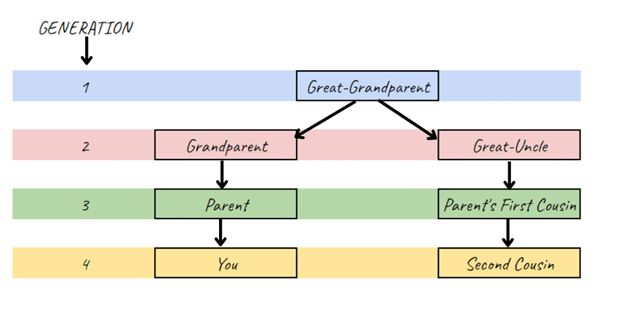
This is why when two people share a great grandparent as their MRCA (your grandparents were siblings) they are second cousins.
How about third or fourth cousins?
Using this logic, we can just as easily figure out more distant cousin labels. Your third cousin, for instance, is someone of your same generation with whom you share a common great-great-grandparent. Your great-grandparents were siblings, your grandparents were first cousins, and your parents were second cousins.
Your fourth cousin would be someone you share a great-great-great grandparent with. There are 4 generations between you and that shared ancestor – you > parent > grandparent > great-grandparent > great-great-grandparent > great-great-great-grandparent).
So, what is a first cousin once removed?
The removed designation comes into play when a cousin is born into a different generation than you.
Now, just to be perfectly clear, when we say “generation,” we’re not referring to Boomers, Gen Xers, or Millennials. Those demographic labels were created in the 20th century to help businesses and advertisers understand the different attitudes, motivations, and shared historical experiences of a group of people born within a roughly 20-year span. So, just because you have a cousin who witnessed World War II, while you were just a kid when the Vietnam War ended, doesn’t necessarily mean you’re of different ancestral generations.
Your first cousin once removed, then, is the child of your first cousin. You and your first cousin once removed do not share a common grandparent, because you were born in different generations of your family line. Your grandparent is their great-grandparent, your great-grandparent is their great-great-grandparent, and so on.
If your first cousin once removed has a child, that child is now two generations away from you, and would therefore be your first cousin twice removed (or, two generations removed from you). In other words, that child is your first cousin’s grandchild.
What is a second cousin twice removed?
Your second cousin twice removed is the grandchild of your second cousin. They are two generations away from you, because, remember — you and your second cousin are of the same generation and share a great-grandparent.
The more generations that separate you and a cousin, and the further back you have to trace your family tree to determine if you share a common great-grandparent, the more numbers you’ll have to add to your cousin relationship. Calculating these when it comes to a distant relative or long deceased person in your tree can seem difficult, but once you have a tree laid out where you can count the generations you will always be able to with the advice in this guide – whether that’s a fifth cousin or a second cousin 12 times removed.
Once you understand that you’re counting generations to determine how removed you are from a person, and tracking your grandparents to pinpoint whether you have a first, second, or third cousin kinship, though, you’ve mastered the most important tools to calculating cousin relationships!
If you’re looking for a quick reference to help you with these determinations, check out Family History Daily’s handy dandy Cousin Relationship Chart here or read our article for more details on the simple math needed for cousin relationships.
Understanding a Half Cousin
As mentioned, full cousins share, in common, two people who produced children in the same generation, The cousins are descended from different children that these two people produced.
If we only share one of those ancestors (in a single generation), that person would have less genetical material in common and we may call them a half-cousin (such as a half first cousin). Although, generally, this designation is removed for simplicity, it can cause some confusion when determining relationships after a DNA test.
Double Cousins Explained
Some family trees include a somewhat rare, but not unheard-of cousin relationship: Double first cousins. These are cousins of the same generation who share the same two sets of grandparents. This scenario occurs when two siblings marry two siblings from another family; the two couples’ children will be double first cousins.
Let’s say the Mr. and Mrs. Jones have a son and a daughter and Mr. and Mrs. Smith also have a son and a daughter. Imagine that the Jones daughter meets and marries the Smith son. At the wedding, the bride’s brother falls hopelessly in love with the groom’s sister, and they eventually marry. The children of each couple will be double first cousins.

Cousins by Marriage
While a a person with this designation is not your biological cousin, many people do consider cousins of their spouses to be their own, or we may consider a non-biological ancestor’s children (such as a child of a step-grandfather) to be our cousin.
Additionally, step-children in a family often view children from their step-parent’s siblings to be cousins (or step-cousins).
Ultimately, when you remove biological considerations, cousinhood is flexible, you decide who is your family. Building a family tree and determining relationships for may be biologically focused for many, but this is not the only way to do things. Read Who Counts as Family in a Family Tree?
Can DNA results determine cousin relationships?
The growing popularity of genetic genealogy has made understanding cousin relationships more important than ever. To date, more than 15 million people have taken the AncestryDNA test, while 23andMe, a DNA testing service focused primarily on exploring participants’ health, boasts 12 million customers.
Additionally, more than 1.5 million people have uploaded their genetic profiles to GEDmatch, a public DNA database that’s often been used by genetic genealogists to help law enforcement track down suspects in criminal cases. As these and other DNA databases grow, so do your potential connections with cousins.
The International Society of Genetic Genealogy (ISOGG), which advocates for and educates about the “use of genetics as a tool for genealogical research while promoting a supportive network for genetic genealogists,” provides a plethora of information on the science of DNA — so much that it might seem overwhelming to a beginning family historian.
Not to worry, though. When it comes to determining cousin relationships using our DNA data, there are just a few basic guidelines you’ll want to understand.
First, you will share a percentage of your autosomal DNA (the DNA you inherit from both of your parents) with your blood relatives. The percentage you share diminishes as you move from generation to generation as well as further away from shared ancestors. For example, parents and children, who are one generation away from one another, share 50% of their respective DNA. Grandparents, who are separated from their grandchildren by two generations, share 25% of their DNA with the grandkids.
However, if you refer to the ISOGG chart below, you’ll note that you share 25% of your DNA with your grandparents, but also with your aunts and uncles, nieces and nephews, and half-siblings. The chart also shows that if you share 1.536% of your DNA with a person, you’re either their second cousin once removed, half second cousin, first cousin three times removed, or half first cousin twice removed.
The second number you’ll see in your DNA results is the total centimorgans (cMs) you share with a person. A centimorgan is a unit of genetic measurement that refers to the DNA segments you share with others. In the ISOGG chart below, you’ll see that you share an average of 3,400 cMs with your child or parent, 1,700 cMs with your aunt or nephew, and 106.25 cMs with your second cousin once removed, half second cousin, first cousin three times removed, or half first cousin twice removed.

How accurate are DNA percentages and centimorgans?
Because ISOGG is a respected organization and its members are among the top genetic genealogists in the field, we can trust that the Average Autosomal DNA chart above is quite accurate. The key word in that title, though, is “Average,” because when determining familial relationships using only DNA, chances are you’re not going to share an exact percentage or amount of centimorgans with every person with whom you share a certain relationship.
In fact, ISOGG states that “known second cousins on average share 212.5 centiMorgans (cMs), but in extreme cases can actually share as little as 47 cMs or as much as 760 cMs.” That’s a pretty wide range!
Let’s look at my AncestryDNA results. The chart says I should share 50%, or 3,400 centimorgans, of DNA with my mother, but according to AncestryDNA, I share 3,476 cMs. It’s close, but not exactly 3,400.
Likewise, I should share 50%, or 2,550 cMs, with my sister, but in reality, we share 2,578 cMs, which AncestryDNA estimates as 46% to 53%. I should share 1,700 cMs with my maternal uncle, but I share 1,810 cMs. My numbers aren’t exact, but they are very close to the average guidelines provided by the ISOGG organization.
Now, let’s look at some cousin matches.
Ancestry has only tagged one of my DNA matches, Amy, as a cousin who is “removed.” Amy and I share 510 cMs and 7% of DNA. The averages for a first cousin once removed, according to ISOGG, are 425 cMs and 6.25% of DNA; again, this is pretty close.
But look at my next match, Jean. We share even more cMs (464 cMs) and also 7% of DNA, but Ancestry has estimated only that Jean and I are either first or second cousins — a relationship I also share with my third cousin match, Scott.
My point here is that although charts like ISOGG’s provide excellent reference points for average shared DNA, cMs and percentages alone most likely can’t definitively determine a specific cousin relationship for you. For that, you’ll need to use the old-fashioned methods of charting generations and family connections that we’ve shared in this article. As with pretty much every aspect of genealogy, the tried-and-true research methods are usually some of the best — and most fun!
By Patricia Hartley
Here’s Some More Help if You Need It:

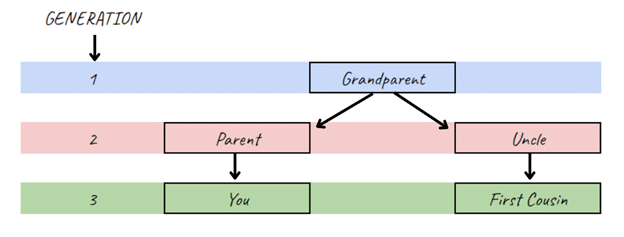
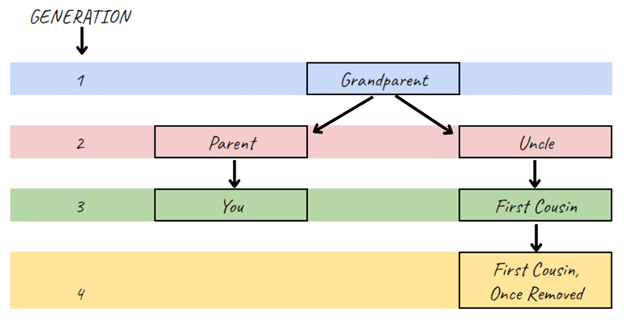
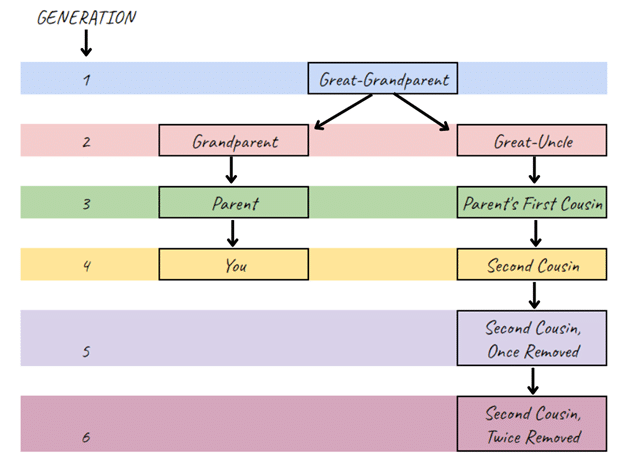
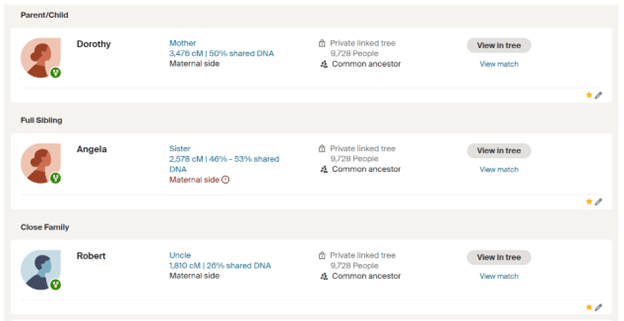
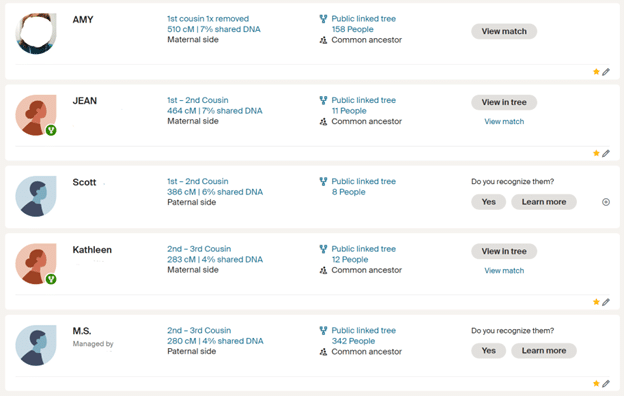
I am confused by Grandparent and siblings of grandparent defined as Great uncle being on the same generation line. Why isn’t it grandparent and siblings of this person defined as grand uncles and grand aunts. The use of your terminology makes great uncle on one generation level, and great uncle or great aunt on the next generation also. Would you give that consideration on your charts. It makes clearer in my opinion the level of ancestor generation. Actually on some relationship charts you see as your article described and other charts as the newest definition. So, grand uncle/aunt is one generation from niece/nephew and great uncle/aunt is 2 generations.
Thank you for this explanation – great to read.
OK, so where does ‘grand’ come in? As far as I’m concerned siblings of grandparents are gand aunts and grand uncles, not great aunts and gerat uncles????????
I also would like a copy of this article. Thank you.
Very informative, I would like to have this complete article. Could you send it attached to my email. I am going to have read this more than once.
Thanks.
As said above,this Genealogical Relationship Concept is quite Interesting.